Home / Service and Warranty / Landscaping and maintenance of your foundations
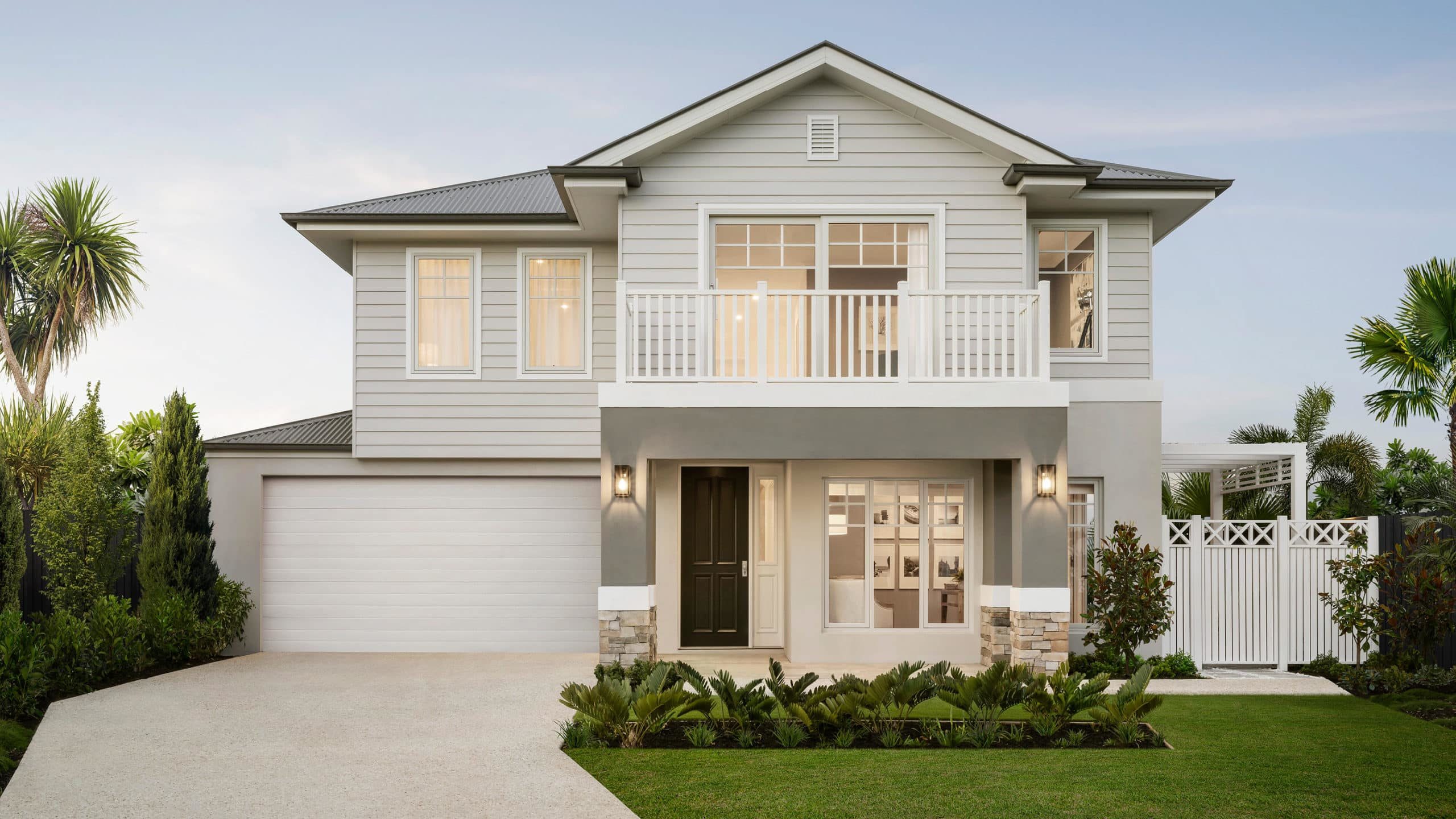
Maintaining your foundations
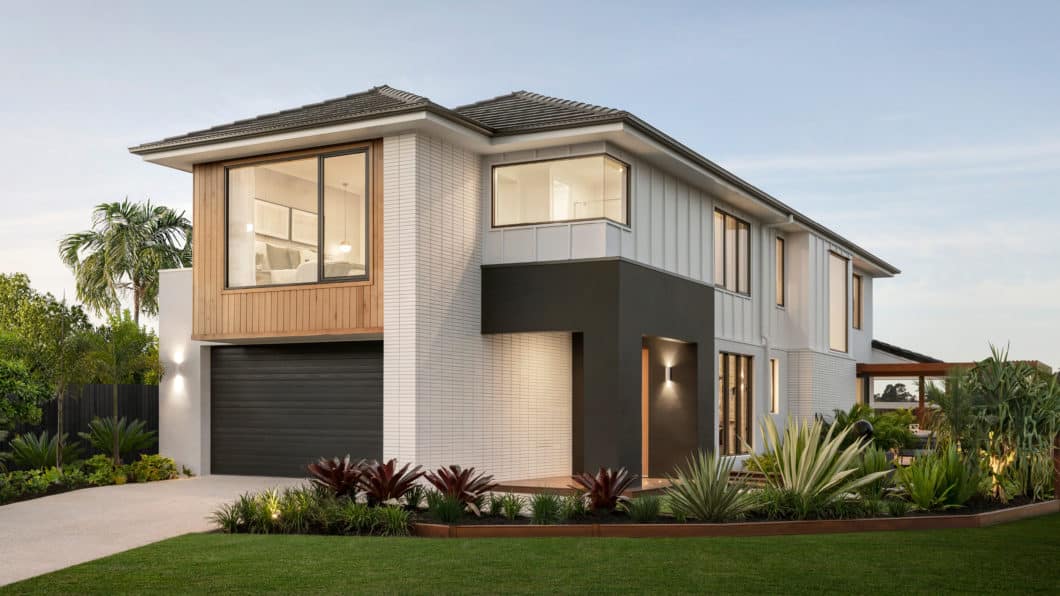
KEY POINTS:
- Your slab is designed to suit normal seasonal changes in soil moisture and movement
- Clay sites require even moisture around the perimeter of the home
- Minor slab movement may lead to minor cracking over time
- Follow the recommended layout for your landscaping
- Ensure surface water and moisture drains away from the perimeter your home
Your entire home is constructed on a concrete slab which is positioned on the ground and often supported by piers (where required) to ensure your home is constructed on solid foundations. This is probably the most important structural aspect of your home, and there are things you can do to maintain it for years to come.
The majority of homes are constructed on what are termed “reactive clay soils”. This type of soil is subject to expansion and contraction depending on seasonal weather and site conditions. Sandy sites are usually not prone to this expansion and contraction.
The Builder is responsible for ensuring that the Slab and Foundations are protected throughout the construction period. However, it is the responsibility of the Homeowner to provide additional drainage provisions to suit their Landscaping works in order to prevent pooling of water/moisture against the dwelling.
All Coral Homes’ slabs are designed to meet Australian Standards AS2870, and as such are intended to accommodate the expected movements caused by seasonal changes in the soil ie swelling when wet and shrinking when dry. The performance of footings under this standard requires normal moisture conditions to be maintained around the house.
If not avoided or addressed promptly, abnormal conditions (other than seasonal changes) including the effect of trees, poor surface drainage and/or leaking plumbing may lead to movement and damage varying from minor to extreme.
The amount of movement that may occur depends on the classification of your site, as defined by Australian Standards AS2870. The expected movements under normal site conditions and seasonal influences are as follows:
Site classification Expected range of movement
A 0
S 0 – 20mm
M 20 – 40mm
H1 40 – 60mm
H2 60 – 75mm
E >75mm (Movement on E sites have been known to move up to, and in excess of 100-150mm in SE QLD)
Depending on the relevant site classification, some minor slab movement may occur which can lead to cracking of building elements such as plasterboard and brickwork. If cracking becomes apparent, the site maintenance conditions should be checked as noted below.
What to do if you notice cracking:
- Ensure there are no leaking external taps
- Ensure there are no leaking sewer or stormwater pipes (this may require engaging a licensed plumbing contractor)
- Check surface water grates are not blocked and effectively draining the surrounding areas
- Check that your property is not being impacted by moisture sources from neighbouring properties
Key things to consider with your landscaping to avoid structural damage to your home:
- Keep plants, trees and garden beds well away from the perimeter of your home
- Sprinkler systems should only be used in gardens and lawns well away from the home
- Take care when watering to ensure even moisture is being applied around the perimeter of the home
- Position any ponds or water features away from your home
- Direct surface water away from the building; do not allow water to be trapped or pool near your home
- Ensure the weepholes in your brickwork are never covered or obstructed
- Maintain a 1:20 gradient fall (ie 50mm over 1m) away from the building when laying turf or other ground coverings
- Any concrete pavements should be constructed in a way that will not impede surface water flowing away from the building or cause water to pond adjacent to the footings causing clay foundations to swell
- Any concrete pavements should be laid hard adjacent to the slab edge so as to not cover the 75mm exposed edge and separated by a compressible material and mastic sealer. Pavements must also maintain adequate fall away from the home.
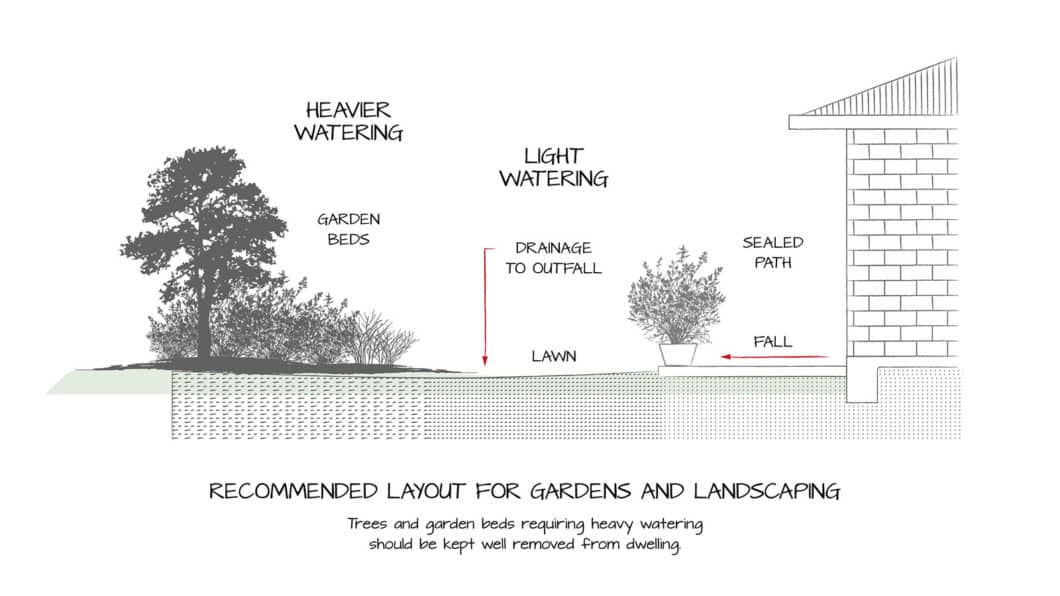
Site drainage and sloping sites
Site conditions including the location of retaining walls, paths, swimming pools, future structures or proposed extensions should all be considered when preparing your block for correct surface water flow.
A stormwater and roof water drainage management plan should be considered and take into account water flowing from adjoining properties.
Care should be taken when selecting trees and, as a guide, trees should not be placed within the distance of their mature height from the house depending on the site classification and whether they are to be planted in a line or in a group.
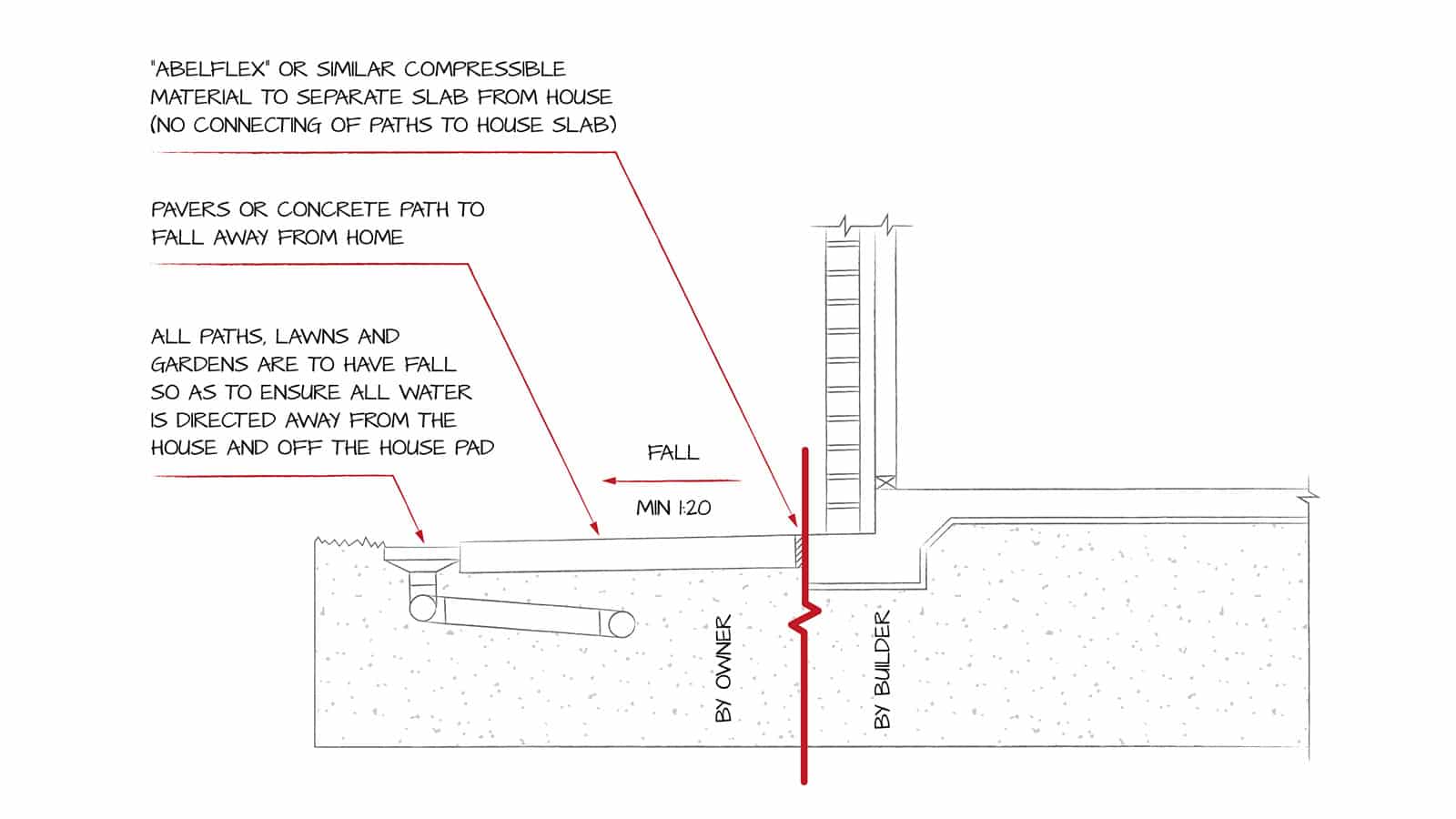
Surface water grates
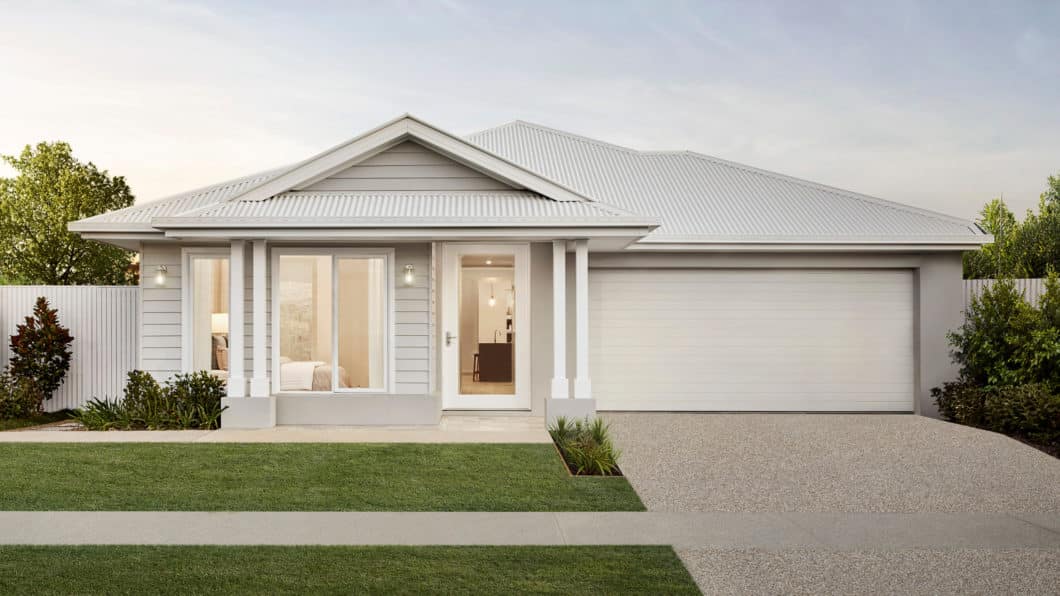
KEY POINTS:
- Surface water grates channel water away from your home
- The screening fabric on each surface water grate can be removed after your landscaping is complete
- It’s your responsibility as the homeowner to maintain the screen fabric if it becomes blocked or damaged prior to completion of your landscaping
Surface water grates are usually positioned on the cut or excavated side of the home. Their purpose is to channel surface water away from the house area via stormwater pipes to prevent water ponding near the house. If ponding occurs this has potential to cause damage to the structural integrity of the house.
Each surface water grate has a screening fabric placed temporarily to prevent mud and dirt, etc being washed into it which could cause blockage of your stormwater pipes.
This screening fabric should be left in place until such time as your landscaping has been completed, at which time the fabric should be removed. This can be done by lifting the grate off at the top of the surface water grate box and removing the screening fabric.
It is your responsibility as the homeowner to maintain the screen fabric if it becomes blocked or damaged prior to completion of your landscaping.
The position and height of the surface water grate should only be altered when carrying out landscaping works to ensure the site is adequately drained.
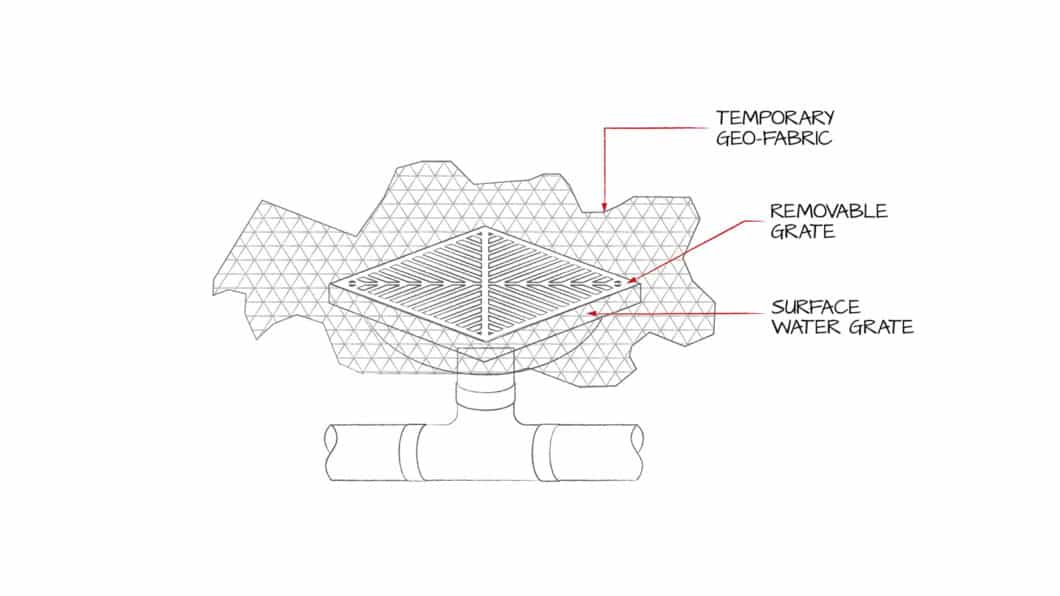
Sediment control
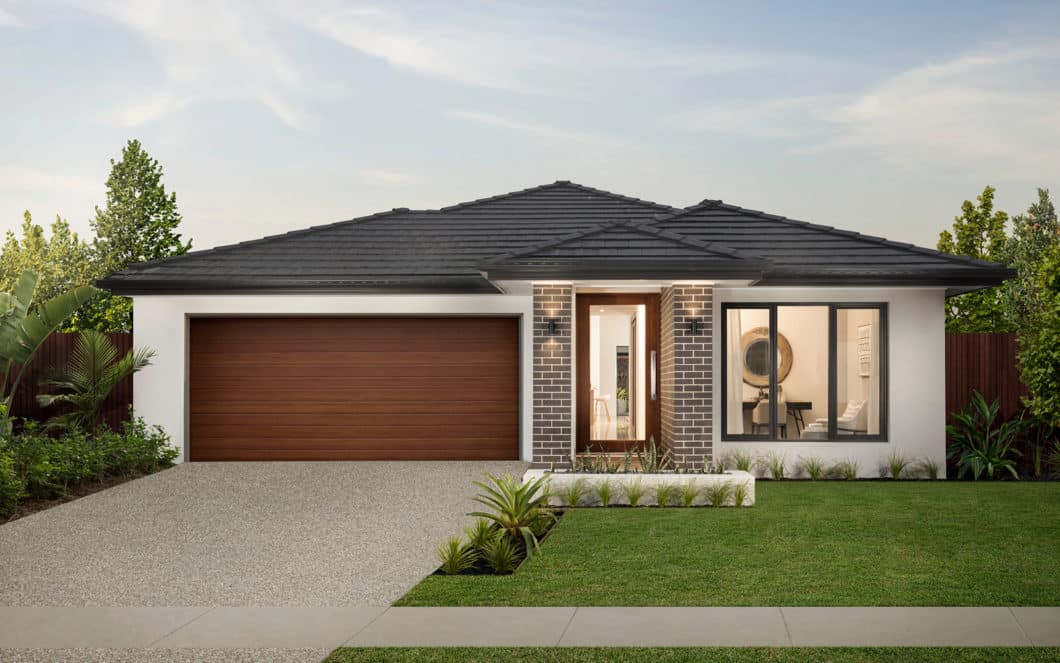
WHAT YOU NEED TO KNOW:
- On the spot fines of up to $3,750 (QLD) and $1,500 (NSW) are applicable if you are found to be in breach of sediment control regulations
- Environmental regulations require you to ensure that there is no sediment, dirt or pollution coming from your property after handover from Coral Homes
- The best way to comply is to get your landscaping and driveway completed as soon as possible after handover
As a new homeowner, you need to be aware of the strict government regulations regarding sediment control and water pollution. These regulations have been introduced to address the environmental impact of movement of sediment from construction sites into surrounding areas and waterways.
During the construction of your home, precautions were taken to ensure that sediment control from your block was maintained within the regulation standards, and that there was no impact to surrounding areas. In doing so, we may have erected barriers or used other retention methods. If so, we have left these materials on your site after the completion of construction for future use by you where appropriate.
Now that construction is completed, you will be liable for any future sediment control as the homeowner. On the spot fines of up to $3,750 (QLD) and $1,500 (NSW) are applicable if you are found to be in breach of the regulations. This could be as simple as your car dropping excessive mud onto the road from your front yard.
If you find you need to continue using some form of sediment retention on your property, you should regularly check the positioning and condition of any methods you have employed to ensure you are not liable for any fines due to effects outside of your control, and also to ensure that sediment erosion does not impact negatively on your new home construction.
Note:
The contents of this page are intended as a guide only. Please refer to your HIA contract which takes precedence to the information shown. The term “maintenance period” is referred to as the “defects and liability period” in your HIA contract. For more information please refer to a Coral Homes representative.
